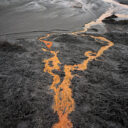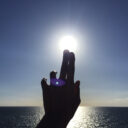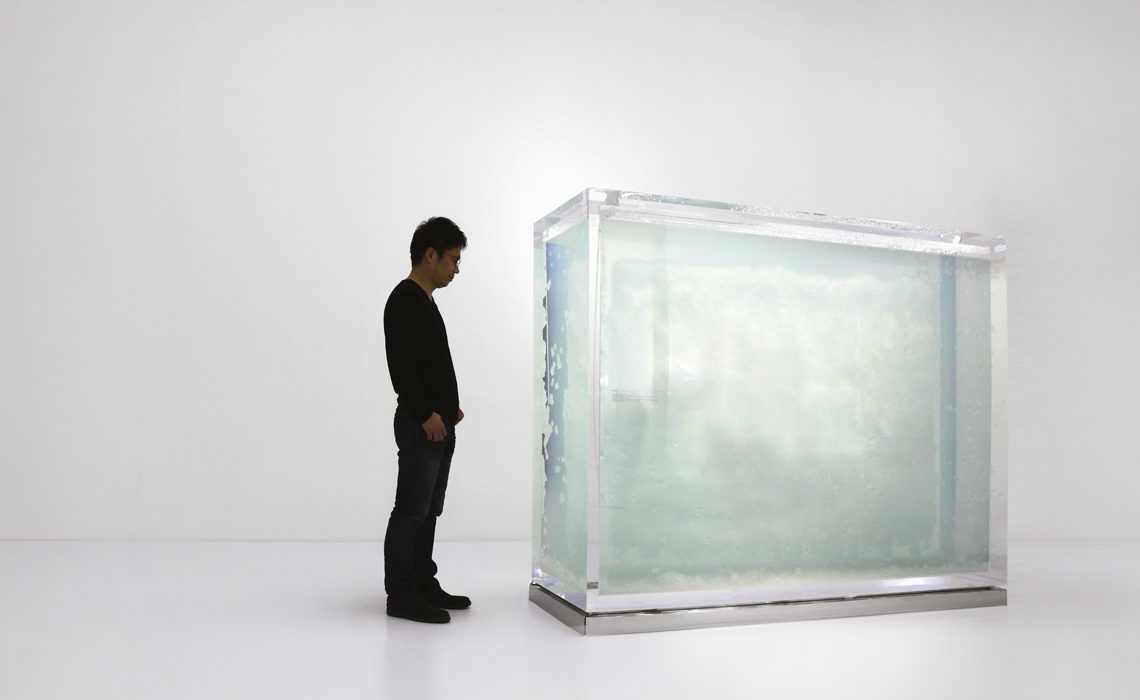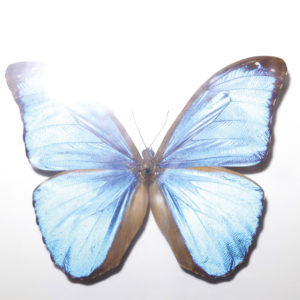Tokujin Yoshioka e il design. E penso subito a La grammatica della fantasia di Gianni Rodari che ci mostra come la fantasia pura non esista, perché ciò che appare ‘fantastico’ è il frutto rintracciabile di associazioni di elementi (ricordi, desideri, conoscenze, esperienze, errori) che, variamente collegati, generano il nuovo. Così i prodotti, le architetture, le installazioni e gli interni poetici e sorprendenti di Yoshioka risultano da un processo di ricerca e sperimentazione serio e laborioso. Lo sviluppo progettuale del designer giapponese è individuabile; è una linea di ricerca che si snoda tra esiti diversi ma riconducibili alla medesima esplorazione. Insomma, il risultato è accidentale, ma il percorso è definibile.
L’imprevedibilità formale crea nei suoi lavori un’aura magica scollegata dall’iter progettuale: l’inaspettato è lo spazio di potenzialità. Ciò che è solido e concreto (materiali, strutture, dispositivi tecnologici) diventa incorporeo e offre a ogni osservatore la propria esperienza percettiva. Le opere e i prodotti incantano e seducono ponendo al centro il fruitore. “I messaggi non sono espressi dalla materialità degli oggetti che produco ma dalle sensazioni che sanno esprimere. Chi si approccia ai miei prodotti e alle mie opere deve provare meraviglia”.
Ho scoperto Tokujin Yoshioka – designer con studio omonimo a Tokyo dove si è diplomato alla Kuwasawa Design School – tanti anni fa, durante un Salone del Mobile di Milano. Prima in una scenografica installazione per Lexus e il suo Design Award dove una cascata di fibre trasparenti, corrispondenti a 700 km lineari, nascondeva l’ultimo modello di automobile del marchio giapponese e uno strano prototipo di sedia interamente realizzato con fibre di poliestere, la PANE chair, uno dei prodotti simbolo del designer che racconta il suo personalissimo modo di intendere e fare design. A partire dai materiali e dai processi, senza pensare alla forma, quella arriverà, sarà casuale e per questo sorprendente. La PANE chair è composta da fibre di poliestere cotte in un involucro di carta come un panettone o un muffin. Un procedimento simile alla cottura tradizionale del pane (da qui il nome) che stabilizza la forma e rende le fibre strutturali.
Poco tempo dopo, per gemmazione, nasce la PANNA chair, prodotta da Moroso. Dal prototipo alla sua industrializzazione con le dovute rinunce e i necessari adeguamenti alle possibilità produttive, ma sempre nel solco della precedente ricerca. Coerenti in quel periodo anche le installazioni e i progetti di interior design per gallerie, musei e brand di moda. Uno su tutti Issey Miyake, che l’ha visto collaboratore sin dagli esordi professionali (suoi gli interni di molti flagship store e boutique nel mondo, suoi anche alcuni oggetti come orologi e bottiglie di profumo).
Un altro importante e duraturo filone di ricerca è quello sui cristalli con la sperimentazione sulla formazione di strutture naturali composte attraverso il processo di cristallizzazione, come nell’opera Spider’s Thread presentata durante la mostra personale “TOKUJIN YOSHIOKA_Crystallize” al Museum of Contemporary Art di Tokyo: sette fili sottili tesi e stretti intorno al telaio a formare uno schizzo tridimensionale di una sedia a mezz’aria dove vengono fatti crescere i cristalli che finiranno di disegnare la seduta. In questo processo di apparizione insiste la sua poetica; nel divenire, nel cambiamento continuo, nell’impermanenza.
E ancora la luce, indagata nel suo farsi materia e smaterializzare lo spazio. Ne sono esempio alcune sue celebri installazioni come la Rainbow Church, uno spazio definito dai colori dell’arcobaleno generati da un monolite composto da 500 prismi di cristallo che filtrano e scompongono i raggi luminosi creando un suggestivo effetto ascetico. O ancora, per citare uno dei più recenti (e premiati) lavori, S.F_Senses of the Future, progetto creato in collaborazione con LG, un’installazione composta da alcune sedie futuristiche (S.F chair) realizzate utilizzando display OLED, e da un grande muro di luci (Wall of the Sun), largo 16 metri e alto 5, realizzato con oltre 30.000 singoli moduli di luce OLED, che danno alla barriera luminosa un inatteso senso di evanescenza.
In questo intrecciarsi di ricerche, Yoshioka, esperto funambolo, supera agilmente tutti i confini: da settori produttivi diversi – moda, arredamento, cosmesi -, a differenti scale di progettazione – dal piccolo oggetto all’architettura. Perché come la fantasia, anche il design ha bisogno della sua tecnica, ma con questa può volare alto, molto alto.
Tokujin Yoshika and design. I immediately think of The Grammar of imagination by Gianni Rodari which shows us how pure imagination does not exist, because what appears ‘imaginary is the traceable fruit of associations between elements (memories, desires, knowledges, experiences, errors) that, variously linked, give birth to something new. In this way, the products, architectures, the poetic and surprising interiors of Yoshioka emerge from a research process, a strenuous and serious experimentation. The project development of the Japanese designer is identifiable: it is a line of research unfolding among different outcomes, nevertheless retraceable to the same exploration. In short, the result is accidental, while the path is defined.
The formal unpredictability creates in his works a magical aura disconnected from the design process: the unexpected is the space of potential. What is solid and tangible (materials, structures, technological devices) becomes incorporeal and offers the observers their own perceptual experience. Works and products enchant and seduce, placing the bystander at the center. “Messages are not transmitted by the materiality of the objects I produce, but thanks to the feelings they can convey. Whoever approaches my products and my works must feel a sense of wonder”.
I discovered Tokujin Yoshioka – designer with a studio of the same name in Tokyo, where he graduated at the Kuwasawa Design School – many years ago, during a Salone del Mobile in Milan. First in a spectacular installation for Lexus and their Design Awards, where a waterfall of translucent fibers, amounting to 700km, hid the latest automobile model of the Japanese brand and a curious prototype of a chair entirely realized from polyester fibers, the PANE chair. One of the product-symbols of the designers that tells of his personal way of interpreting and making design. Starting from the material and the construction, without thinking about the final shape, that will eventually come, will be casual and for this reason, surprising. The PANE chair is made up of polyester fibers baked in a paper wrapping just like a panettone or a muffin. A procedure very similar to the traditional bread baking (hence the name) that stabilizes the shape and creates a structure among the fibers.
Shortly afterwards, by budding, the PANNA chair was born, produced by Moroso. From the prototype to its industrial production with the due sacrifices and the necessary adjustments for productive possibilities, yet always following the previous research. Consistent with that period as well, the installations and the interior design project for galleries, museum and fashion brand. One above all, Issey Miyake, a partnership born ever since his professional debut (his are the interiors of many flagship stores and boutiques around the world, as many other objects as watches and perfume bottles).
Another important and lasting research subject is the research on crystals with the experimentation on the formation of natural structures formed through a crystallization process, like in the piece Spider’s Thread shown during the personal exhibition “TOKUJIN YOSHIOKA_Crystallize” at the Museum of Contemporary Art of Tokyo: seven thin threads, tightened around the frame, forming a three-dimensional draft of a chair in mid-air, where the crystals that would complete the drawing of the chair are growing. In this process of apparition, his poetic is clear; in the becoming, in the constant changing, in the impermanence.
And still, the light, examined in its becoming matter, dematerializing space. Examples of this are some of his most famous installations, such as the Rainbow Church, a space defined by the colors of the rainbow generated by a monolith formed by 500 crystal prisms, filtering and decomposing the light rays creating a suggestive ascetic effect. Again, to quote one the most recent (and awarded) works, S.F. Senses of the Future, a project realized in partnership with LG, an installation composed by some futuristic chairs (S.F chair) realized employing OLED displays, and by a large wall of lights (Wall of the Sun), 16 meters large and 5 meters tall, realized with more than 30.000 single OLED light modules, giving the bright barrier an unexpected sense of evanescence.
In this intersection of researches, Yoshioka, master tightrope walker, swiftly overcomes all boundaries: different production fields, ranging from fashion to home furnishing and cosmetics, different scales in design, from small objects to architecture. Because, just as imagination, design needs its technique, and with technique it can fly high, very high.








No Comments